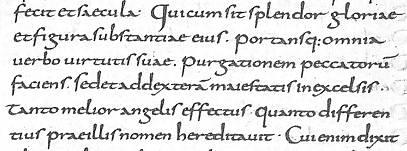Script Type : minuscule
Date : mid 9th century
Location : France, Germany, England, Spain, northern Italy, Scandinavia; this example from Tours, France
Function : Book hand and basis for document hands























Distinctive letters : This segment from a Latin Vulgate Bible shows the Caroline minuscule script in its purest and most reformed mode. Individual letter forms are standardised and the ligatures which added individuality to the pre-Carolingian scripts, but also decreased their general legibility, are largely absent. We are looking here at a precise and standardised alphabetic mode of writing, before the whole process began to diversify again. It is very easy to read, so I guess the interest is historic rather than being a paleographical puzzle.
Most letter forms would be familiar to us. The letter a has the uncial form, although written as a minuscule. The letter e is closed with an extended horizontal stroke. The letter g is mostly open, reminiscent of earlier scripts, and when it is closed it appears to be almost by accident. The letter t is short with a broad horizontal cross stroke. The letter x has a curved descender.
There is only one form of s, a tall form which sits on the baseline, while f has a short descender. There is only one form of r.
The ascenders of b, d, h and l are straight with a slightly wedged shape. The descender of q is straight.
The letters i and j are identical, as are u and v.
There are no examples of k, w, y or z.
All letters are carefully differentiated, so there is no need for dots on i, or any confusion between the smaller letters. Each letter has a single unique form. It is all so clear and neat. It couldn't last.
For a quick transcript, pass the cursor slowly along the lines of text. For a more detailed look, including at the hierarchies of headings employed, proceed to the paleography exercise.
Paleography
Exercises using Flash ![]()
Requires at least the Flash 5 plugin
If you are looking at this page without frames, there is more information about medieval writing to be found by going to the home page (framed) or the site map (no frames).